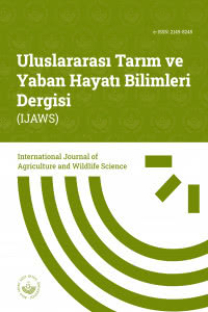Türk Kavuzlu Buğday Hatlarının Amaranthus retroflexus L. ve Lolium perenne L. Tohumlarının Çimlenmesi Üzerine Allelopatik Etkileri
Kavuzlu buğdaylar, siyez, gernik, yabancı ot, inhibisyon etkisi
The Allelopathic Effects of Turkish Hulled Wheat Lines on Germination of Amaranthus retroflexus L. and Lolium perenne L. Seeds
Hulled wheats, einkorn, emmer, weed, inhibition effect,
___
- Arif, M., Cheema, Z. A., Khaliq, A., & Hassan, A. (2015). Organic weed management in wheat through allelopathy. International Journal of Agriculture and Biology, 17, 127-134.
- Aslam, F., Khaliq, A., Matloob, A., Tanveer, A., Hussain, S., & Zahir, Z. A. (2017). Allelopathy in agro-ecosystems: a critical review of wheat allelopathy-concepts and implications. Chemoecology, 27, 1-24.
- Bashir, T., Anum, W., Ali, I., Ghaffar, A., Ali, L., Raza, M.U., Javed, Z., Zafar, A., Mahmood, N., & Shabir, A. (2018). Allelopathic effects of perennial sow thistle (Sonchus arvensis L.) on germination and seedling growth of maize (Zea mays L.). Allelopathy Journal, 43(1), 105-116.
- Bertholdsson, N. O. (2005). Early vigour and allelopathy – two useful traits for enhanced barley and wheat competitiveness against weeds. Weed Research, 45(2), 94-102.
- Coskun, I., Tekin, M., & Akar, T. (2019) Characterization of Turkish diploid and tetraploid hulled wheat lines for some agromorphological traits. International Journal of Agriculture and Wildlife Science, 5(2), 322-334.
- Dong, S. Q., Ma, Y. Q., Wu, H. W., Shui, J. F., Ye, X. X., & An, Y. (2013). Allelopathic stimulatory effects of wheat differing in ploidy levels on Orobanche minor germination. Allelopathy Journal, 31(2), 355-366.
- Inderjit., Olofsdotter, M., & Streibig, J. C. (2001). Wheat (Triticum aestivum) interference with seedling growth of perennial ryegrass (Lolium perenne): influence of density and age. Weed Technology, 15, 807-812.
- Kaplan, M., Akar, T., Kamalak, A., & Bulut, S. (2014). Use of diploid and tetraploid hulled wheat genotypes for animal feeding. Turkish Journal of Agriculture and Forestry, 38, 838-846.
- Kitis, Y. E., Koloren, O., & Uygur, F. N. (2016). Allelopathic effects of common vetch (Vicia sativa L.) on germination and development of some weed species. Journal of Central Research Institute for Field Crops, 25, 100-106 (In Turkish).
- Konvalina, P., Capouchová, I., Stehno, Z., & Moudry Jr, J. (2012). Genetic resources of emmer wheat and their prospective use in organic farming. Lucrări Ştiinţifice, 55(2), 13-18.
- Konvalina, P., Stehno, Z., Capouchová, I., Zechner, E., Berger, S., Grausgruber, H., Janovská, D., & Moudry Sr, J. (2014). Differences in grain/straw ratio, protein content and yield in landraces and modern varieties of different wheat species under organic farming. Euphytica, 199, 31-40.
- Kruse, M., Strandberg, M., & Strandberg, B. (2000). Ecological Effects of Allelopathic Plants- A Review. Ministry of Environment and Energy National Environmental Research Institute (NERI) Technical Report No. 315, Silkeborg, Denmark.
- Li, S. L., You, Z. G., Li, S. R., & Zhang, L. (1996). Allelopathy of wheat extraction to the growth of two weeds. Chinese Journal of Biological Control, 12, 168-170.
- Ma, Y. (2005). Allelopathic studies of common wheat (Triticum aestivum L.). Weed Biology and Management, 5, 93-104.
- Nakhforoosh, A., Grausgruber, H., Kaul, H. P., & Bodner, G. (2014). Wheat root diversity and root functional characterization. Plant Soil, 380, 211-229.
- Nakimichi, N. (2015). Adaptation to the local environment by modifications of the photoperiod response in crops. Plant and Cell Physiology, 56(4), 594-604.
- Narwal, S. S. (2010). Allelopathy in ecological sustainable organic agriculture. Allelopathy Journal, 25(1), 51-72. Shewry, P. (2018). Do ancient types of wheat have health benefits compared with modern bread wheat?. Journal of Cereal Science, 79, 469-476.
- Tekin, M., Cengiz, M. F., Abbasov, M., Aksoy, A., Canci, H., & Akar, T. (2018). Comparison of some mineral nutrients and vitamins in advanced hulled wheat lines. Cereal Chemistry, 95, 436-444.
- Wu, H., Pratley, J., Lemerle, G., & Haig, T. (2000). Evaluation of seedling allelopathy in 453 wheat (Triticum aestivum) accessions against annual ryegrass (Lolium rigidum) by the equal-compartment-agar method. Australian Journal of Agricultural Research, 51, 937-944.
- ISSN: 2149-8245
- Yayın Aralığı: 3
- Başlangıç: 2015
- Yayıncı: BOLU ABANT İZZET BAYSAL ÜNİVERSİTESİ > ZİRAAT VE DOĞA BİLİMLERİ FAKÜLTESİ
Yulafın (Avena sativa L.) Verim ve Kalitesine Çinko Uygulaması ve Ekim Zamanının Etkileri
İmren KUTLU, Yaşar KARADUMAN, Nurdilek GÜLMEZOĞLU
TR61 Bölgesinde Genç Çiftçi Projesi Desteğinden Yararlanmayı Etkileyen Faktörlerin Değerlendirilmesi
Tuba BEŞEN, Betül SAYIN, Musa KUZGUN, Dilek KARAMÜRSEL, Mehmet Ali ÇELİKYURT, Meltem EMRE, Fatma Pınar ÖZTÜRK, Şerife Gülden YILMAZ, Duygu BİROL
Farklı Çim Tür ve Çeşitlerinin Topraksız Ortamda Bazı Gelişim Parametrelerinin Belirlenmesi
Deniz ÇAKAR, Seçil Akıllı ŞİMŞEK, Tuncay CAN, Yakup Zekai KATIRCIOĞLU, Salih MADEN
İlhan SUBAŞI, YUSUF ARSLAN, Oğuzhan AYDIN, Faheem Shehzad BALOCH, MAHMUT ÇAMLICA, Vahdettin ÇİFTÇİ
Germencik (Aydın) İlçesinde Yetiştirilen Sarılop İncirlerinde (Ficus carica L.) Klon Seleksiyonu
Onur ŞAHİN, Özer KURT, Önder Bayram ÇOBAN
Yarı Kurak İklim Koşullarında Eğimin Farklı Bölümlerinin Aşınıma Duyarlılıklarının Karşılaştırılması
Kübra POLAT, İrfan OĞUZ, Rasim KOÇYİĞİT
İHSAN CANAN, Akgül TAŞ, Muttalip GÜNDOĞDU
Ekolojik Köprülerin Potansiyel Yer Seçimleri: İzmir-Çeşme Otoyolu Örneği
